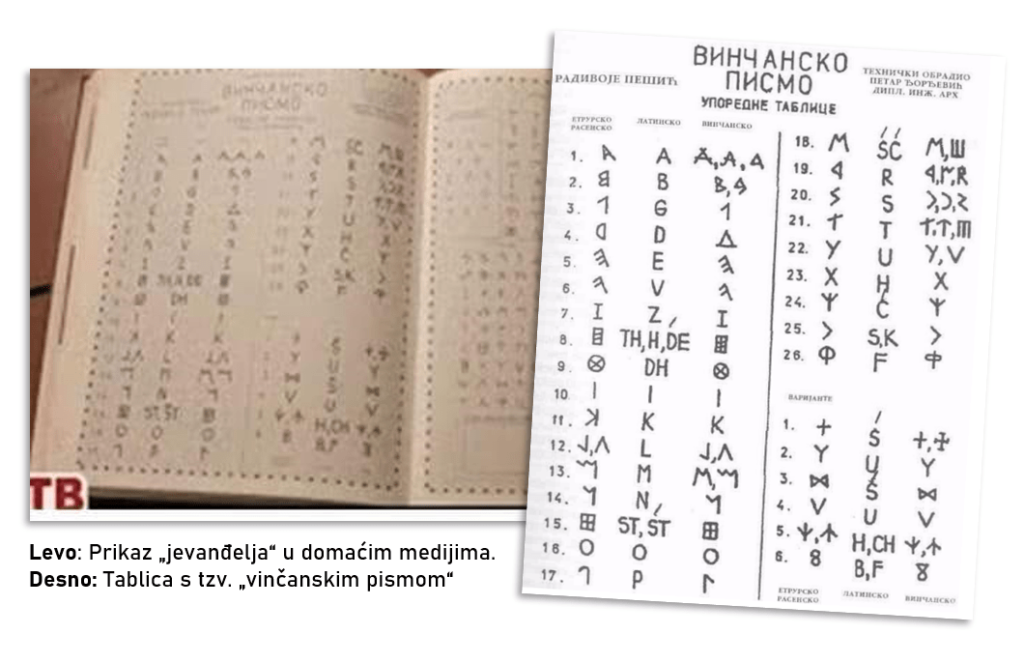Original article (in Serbian) was published on 09/01/2023
Web portal Balkan press recently published an article entitled “In Ireland, there is a ‘Serbian Gospel’ written at the end of the 5th century – in Serbian!”, with the claim that these “four Gospels” are kept in the National Museum of Ireland in Dublin. We decided to check in the mentioned museum this allegation, already absurd because of the time frame and see if there is at least something similar from a later period. The museum replied that such or a similar artefact does not exist in their collection.
Web portals Nacionalist, Glas javnosti, as well as Facebook pages Ovo je Srbija and Srbska skrivena istorija wrote about the preservation of this manuscript in Ireland, which “confirms that Miroslav’s Gospel is NOT the first Serbian Gospel”.
Where does the image of the supposed gospel come from?
Along with their texts, the mentioned media also published a photo of an open book on the pages of which “srbica” is allegedly written. However, that picture does not depict the gospel. It originates from the video of the National Television (the logo of this media can be seen or glimpsed in the published photos) entitled “Vinca script” from 2017.
In this video, publicist Ljubomir Kljakic mentions the name of Radivoje Pesic and his systematization of the so-called “Vinca script”, while in the background a book is shown with the text of the title “Primo alfabeto dell’uomo” – “The first letter of man”. On the next, overturned page, Pesic’s interpretation of the signs of the “Vinca script” is shown, which is a photo that the media used to illustrate the “Serbian gospel” from Ireland. A clearer description of the “serbica of Vinca” can be found in Jovan Deretic’s book “Ancient Serbia”, where there is also no mention of any gospel.

Right: Table with the so-called “Vinca script”
Is there any truth in the theory about the “Vinca script”?
Of course not. From a scientific point of view, ideas about Serbian, that is, the “Vinca script” as “the oldest written script in the world, from which all the literacies of Europe arose” (Deretic), can be considered charlatan. Aleksandar Palavestra from the Department of Archeology of the Faculty of Philosophy in Belgrade dealt with this question in the paper “Inventing tradition: ‘Vinca script’”. He disputes Pesic’s statements and his systematization, that is, the attempt to prove that Serbian is the “oldest script of man”.
“Someone has to say that all this, starting with the ‘genius Pesic’s discovery’, is just one of the emperor’s new suits. Based on the records so far, it can be concluded that there is no Vinca script. Not even a protoscript! After the exhibition in Novi Sad (and the published catalogue), I would say that mostly, apart from sporadically, there are no signs. The ‘Vinca script’ is just one link in a chain of different invented traditions, which flourish always in the circumstances of a shaken identity of a community, as a surrogate of legitimacy and cement of national and social cohesion”, states Palavestra in his work.
Interestingly, two of our other Cyrillic Gospels are preserved in Dublin – the Serbian Fourteenth Gospel (from the end of the 13th / beginning of the 14th century) and the Gospel of Nicholas (from the end of the 14th and the beginning of the 15th century), in the library of Chester Beatty.



